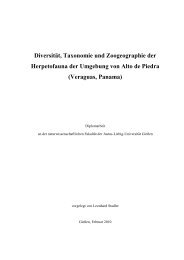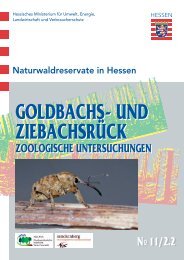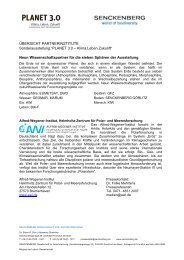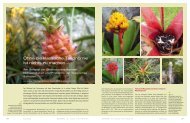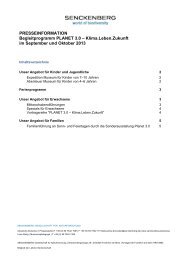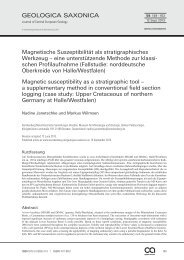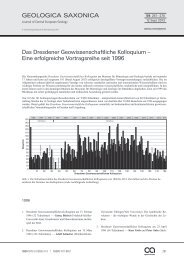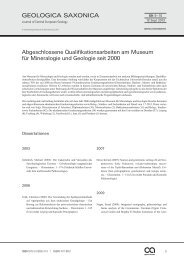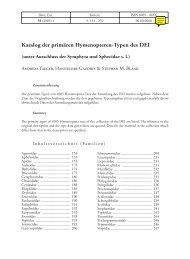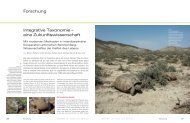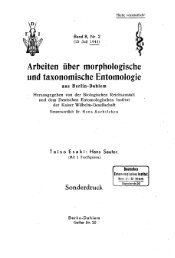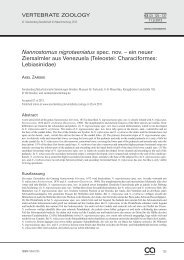Taxonomic publications: past and future - Senckenberg Museum
Taxonomic publications: past and future - Senckenberg Museum
Taxonomic publications: past and future - Senckenberg Museum
Create successful ePaper yourself
Turn your PDF publications into a flip-book with our unique Google optimized e-Paper software.
Burckhardt & Mühlethaler (eds): 8 th GfBS Annual Conference Abstracts 34<br />
3D-Reconstructions of the chaetal arrangement contradict ideas on a common<br />
inheritance of the chaetal inversion in Sabellariidae <strong>and</strong> Sabellidae (Annelida)<br />
D. Kieselbach & H. Hausen<br />
Sabellida <strong>and</strong> Sabellariidae are considered to be sister groups in a number of recent<br />
investigations. This assumption is based mainly on a special distribution of certain<br />
types of chaetae along the body called chaetal inversion. In taxa, which are assumed<br />
to be close relatives of Sabellariidae <strong>and</strong> Sabellida, capillary chaetae form the<br />
notopodial bundles, whereas uncini or homologous hooked chaetae occur only in<br />
neuropodia throughout the body. This meets the situation in the thoracic setigers in<br />
Sabellida, but abdominal notopodia bear uncini <strong>and</strong> abdominal notopodia bear<br />
capillary chaetae. In Sabellariids uncini occur only in notopodia of the abdomen <strong>and</strong><br />
lack completely in the thorax <strong>and</strong> parathorax.<br />
The only correspondance between Sabellida <strong>and</strong> Sabellariidae is the notopodial<br />
position of uncini within the abdomen. To figure out, whether this unusual distribution<br />
evolved once in a common lineage to Sabellariidae <strong>and</strong> Sabellida the sabellids<br />
Branchiomma bombyx, Sabella pavonina <strong>and</strong> Fabricia stellaris <strong>and</strong> the sabellariid<br />
Sabellaria alveolata were closely examined by SEM <strong>and</strong> LM. Exact computer-aided<br />
3D models of the chaetal arrangement were performed by reconstruction of complete<br />
series of plastic embedded semi-thin sections. Like in several other polychaete taxa,<br />
all investigated sabellids show transverse rows in all noto- <strong>and</strong> neuropodia<br />
irrespective of the type of chaetae they bear. The thoracic <strong>and</strong> abdominal transverse<br />
rows have a single formative site at the ventral resp. dorsal edge of each row. In<br />
contrast to abdominal neuropodia thoracic notopodia exhibit an additional, short<br />
longitudinal row with an own caudal formative site. This character is regarded as<br />
derived having evolved after the invention of the chaetal inversion. A minor difference<br />
to Fabricia stellaris is found in Branchiomma bombyx <strong>and</strong> Sabella pavonina. Here the<br />
transverse rows of the abdominal neuropodia are transformed into semicircles or<br />
spirals shortly after segment formation. In all Sabellidae the abrupt transition of<br />
capillary chaetae <strong>and</strong> uncini between thorax <strong>and</strong> abdomen is accompanied by a<br />
sudden change of the parapodial morphology. In contrast Sabellaria alveolata shows<br />
a gradual transition that can clearly be seen in the first one to two abdominal<br />
neuropodial fascicles, since they show a mixed composition of chaetae typical for the<br />
parathoracic <strong>and</strong> abdominal region as well as a mixed growing pattern. Moreover,<br />
there is no change in parapodial morphology between parathorax <strong>and</strong> abdomen in<br />
Sabellariidae at all.<br />
Our results do not support ideas on a common evolutionary event that underlies the<br />
distribution of chaetae in Sabellida <strong>and</strong> Sabellariidae. Thus a position of Sabellariidae<br />
close to Sabellida is uncertain <strong>and</strong> further research is highly dem<strong>and</strong>ed.<br />
Org. Divers. Evol. 5, Electr. Suppl. 13 (2005)



